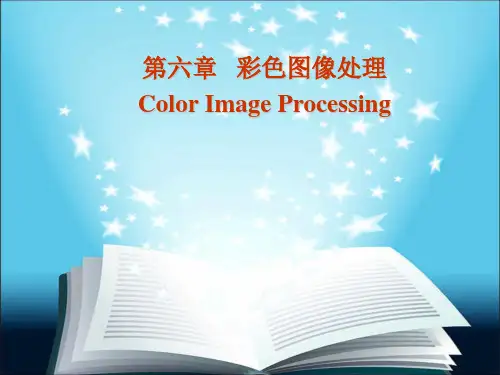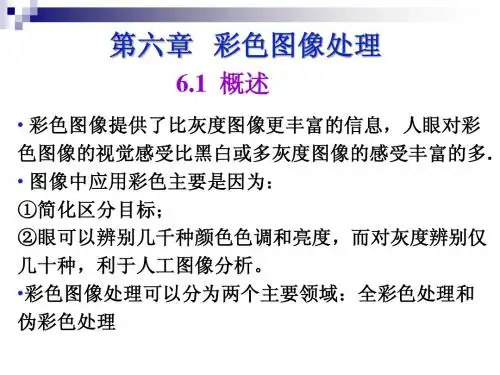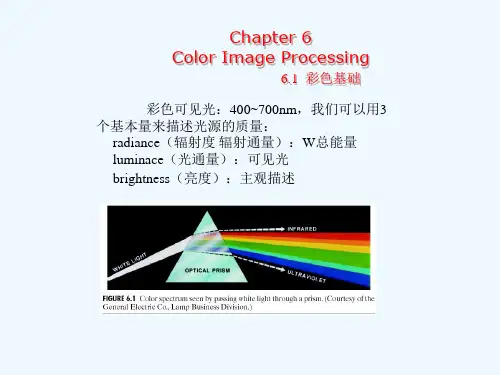第六章 彩色图像处理
- 格式:ppt
- 大小:7.34 MB
- 文档页数:59


彩色图像处理Two principal motivating factors for using color in image processing:1.Color is a powerful descriptor that often simplifies objectidentification and extraction from a scene.2.Humans can discern thousands of color shades and intensities,but just only two dozen of shades of grays.Color image processing includes three major areas:1. Full-color: the images in question typically are acquired witha full-color sensor, such as a color TV camera or scanner.2. false-color:processing intentionally the natural color imagesor multi-spectral sensor images into false color images.3. pesudo-color processing: assigning a color to a particularmonochrome intensity or range of intensities.6.1 color fundamentalsSix bands in color spectrum:Violet, blue, green, yellow, orange and red, each colors blends smoothly into next.The colors of object are often determined by the nature of the light reflected from the object, for example, green objects reflect light with wavelengths primarily in the 500 to 700 nm range.The electromagnetic spectrum of chromatic light ranges from about 400 to700nm, three basic features used to describe the quality of a chromatic light: radiance, luminance, and brightness.Radiance:the amount of energy that flows from the light source, measured in watts (W);Luminance:a measure of the amount of energy an observer perceives from a light source, measured in lumens (lm);Brightness:a subjective descriptor practically impossible to measure.蓝紫色紫蓝色蓝色蓝绿色绿色黄绿色黄色橙色红橙色红色蓝绿红光的吸收率400 450 500 550 600 650 700nmIt is important to keep in mind that having three specific primary color wavelengths for the purpose of standardization does not mean that these three fixed RGB components acting alone can generate all spectrum colors.Secondary colors of light: magenta (red plus blue), cyan(green plus blue), and yellow(red plus green).Secondary colors is the primary colors of pigments or colorants (is defined as one that subtracts or absorbs a primary color of light and reflects or transmits the other two.). So, the three primary colors is also the second colors of pigments.Mixing the three primaries, or a secondary with its opposite primary color, in the right intensities produce white light.Likely, a proper combination of the three pigment primaries, or a secondary with its opposite primary, produces black.brightness, hue, saturationThree characteristics generally used to distinguish one color from another are brightness, hue, and saturation.•Brightness embodies the achromatic notion of intensity.•Hue is an attribute associated with the dominant wavelength in a mixture of light waves and represents dominant color as perceived by an observer.•Saturation refers to the relative purity or the mount of white light (inversely proportional) mixed with a hue.Hue and saturation taken together are called chromaticity. Tristimulus value(三色激励值): the amounts of red, green and blue needed to form any particular color, denoted by X, Y and Z, respectively.Induced brightness•The perceived brightness of the central grating depends on both the orientation and phase of the surroundInduced brightness•The perceived brightness and the contrast of visual stimuli are influenced by surrounding stimuli (Biederlack, Castelo-Branco et al. 2006)••The perceived brightness also increases with the phase offset, which is correlated with the synchrony of neural activityColor gamut of RGB monitor and color printing deviceFrom triangle with threefixed colors as verticeswe can observe that notall colors can beobtained with three fixedprimaries.6.2 Color model (space orsystem)The purpose of a color model is to facilitate the specification of colors in some standard and accepted way, usually can be classified as:1.Hardware-oriented:RGB: for color monitors and a broad class of color video cameras; CMY (or CMYK: cyan, magenta, yellow and black): color printing;2. Application-oriented:HSI (hue, saturation and intensity): corresponds closely with the way humans describe and interpret color. It also decouples the color and gray-scale information, making it suitable for many of the gray-scale technique.6.2.1 RGB color modelBit depth(or pixel depth): the number of bits used to represent each pixel in RGB space.Full color:24-bit RGB color image. The total of colors is (28)3= 16,777,216.RGB 24-bit color cube:Three hidden surface planesin the left color cubeGenerating the RGB image of the cross-sectional color plane (127, G, B)而饱和度S,则由彩色点到灰度轴(或平面色环的原点的距离决定。








